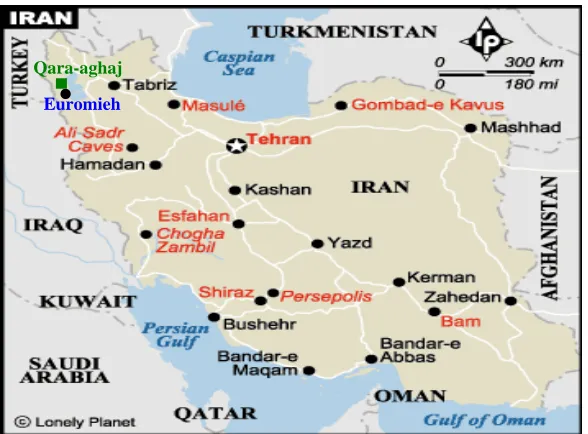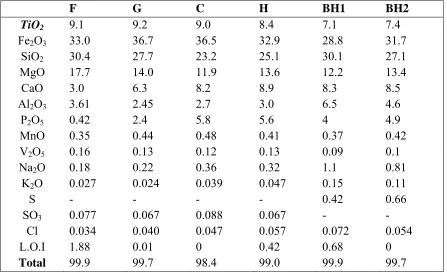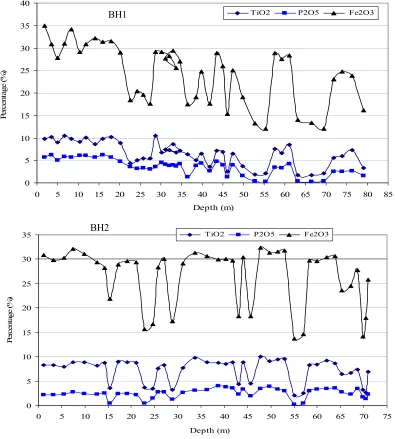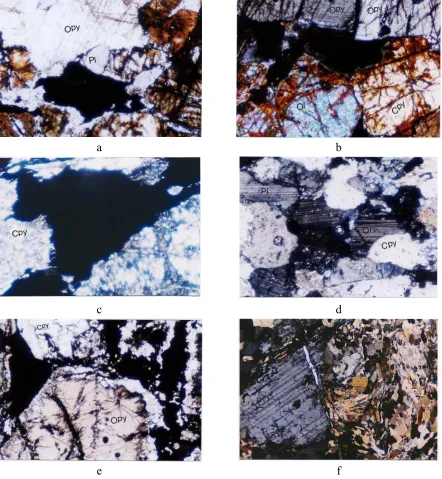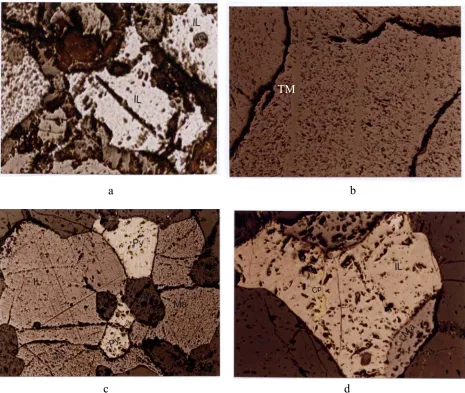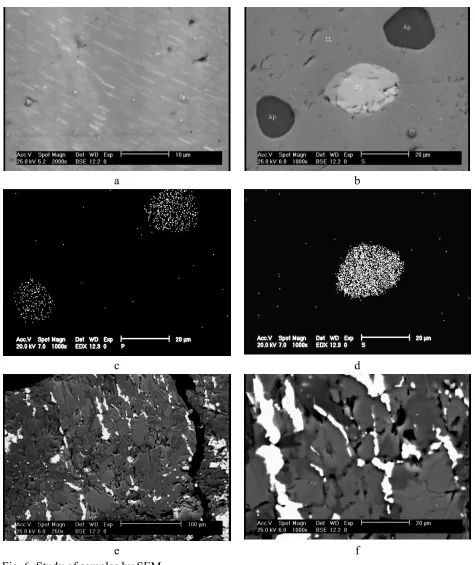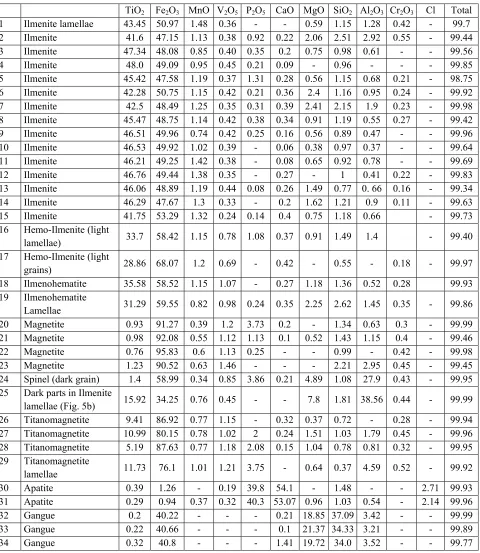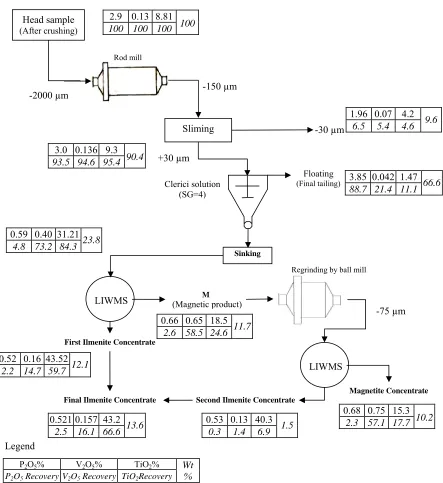247
Applied Mineralogical Studies on Iranian Hard Rock Titanium Deposit
A. Mehdilo and M. Irannajad*
Department of Mining and Metallurgical Eng., Amirkabir University of Technology, Tehran, Iran
*E* Corresponding Author: iranajad@aut.ac.ir, Phone: 0098-21-66419729
ABSTRACT
The Qara-aghaj hard rock titanium deposit has been located in the 36 Km at the North-West of Euromieh, Iran. Mineralogical studies performed by XRD, XRF, Optical microscopy and SEM studies indicated that ilmenite, magnetite and apatite are main valuable minerals. The gangue minerals consist of the silicate minerals such as pyroxene, olivine, plagioclase and some secondary minerals. Ilmenite in Qara-aghaj ore occurs in three forms: ilmenite grains, exsolved ilmenite lamellae in magnetite and ilmenite particles disseminated in silicate minerals. The grain forms liberated in 150µm are only recoverable by physical methods. The maximum content of TiO2 in ilmenite lattice is determined 48% by EDX. Although the ore has 8.8% average grade of TiO2, the recoverable TiO2 is only about 6.72% the studied sample contained 18.3% ilmenite and the amount of recoverable ilmenite is only about 14% (6.72% TiO2). This is due to the ilmenite exsolutions and inclusions in the magnetite and silicate minerals, and the TiO2 in solid solution in the lattices of these minerals. In fact, about 77% of whole ilmenite content of the ore will be recoverable. EDX analysis showed that Fe is substituted partially in ilmenite by Mn and Mg. Some narrow lamellae of hematite are formed inside ilmenite. By analyzing of magnetite, it was found that the V2O5 content is up to 1%. V3+ is found in magnetite lattices by replacing Fe3+. Analyzing of clinopyroxenes indicated that augite, containing Ti, is the main form of this group. Ilmenite, apatite and magnetite are valuable minerals for production of TiO2, P2O5 and Fe, respectively and the V2O5 can be extracted from magnetite as a by-product.
Key Words: Applied Mineralogy, Titanomagnetite, Ilmenite, Magnetite, Apatite, Hard Rock
1. INTRODUCTION
Titanium is widely used as titanium dioxide (TiO2) for production of white pigment [1]. Ilmenite
(FeTiO3, 52.6% TiO2 and 47.4% FeO) is the most common source of titanium dioxide [2]. The
term ilmenite, as used in the titanium industry, commonly covers the entire range from unweathered ilmenite with TiO2 contents below 50% to altered ilmenite containing more than
60% TiO2 [3]. All economically exploitable ilmenite occur as hard-rock resources and beach
sands. The hard-rock titanium deposits have complicated mineralogical characteristics whose identification is the most important from processing viewpoint. The amenability of various iron-titanium deposits to beneficiation is controlled by mineralogical and textural characteristics. In the evaluation of the mineralization and in the design of procedures of mineral dressing, the distribution of the valuable material is a matter of immediate importance. It is necessary to determine whether a given element is occurring in one mineral or several [3]. Considering the magmatic titanium deposits, the majority of the worlds economic rock deposits of titanium minerals are restricted to massive or disseminated anorthositic or gabbroic rocks. They are classified as ilmenite-magnetite deposits, ilmenite-hematite deposits and ilmenite-rutile deposits [3].
Tellnes [4] and Bjerkreim-Sokndal [5] in Norway, Kauhajärvi [6], Lumikangas [7], Koivusaarenneva [3,8], Iso-Kisko [9], Otanmäki [10] and Kalviä [11] in Finland, Sinarsuk V-Ti project in West Greenland [12], the Sept– Iles project in Canada [13], Navaladi and Surungudi area in southern India [14] and Kahnoj beach sands in Iran [15] are some of the most important titanium deposits which have been investigated from applied mineralogical viewpoint.
Fig. 1. Location map of Qara-aghaj deposit.
2. MATERIALS AND METHODS
Four representative samples from exploration faces (F, G, C and H) and two drill core samples from two boreholes (BH1 and BH2) with overall length about 155 m were collected. The crushing of the samples less than 2 mm was done by laboratory jaw, cone and roller crushers. The rod and ball mills were used for grinding of samples. The corresponding polished thin sections were studied for ore and rock-forming minerals and their textural relationships by reflected and transmitted light microscopy. The chemical and mineralogical composition of different samples carried out by X-ray fluorescence (XRF) and X-ray diffraction (XRD). The Philips scanning electron microscopy (model: XL30) was used for description of inclusion, exsolution and other textural relationships. The EDX DX-series PV 9462/30 (model: NEW XL30 144-10) was also used for probe analysis. The Merck clerici solution (SG=4, Art No. =8136) and Aldrich methylene iodide (SG=3.3) were employed in heavy liquid tests.
3. RESULTS
3.1. Chemical and Mineralogical Composition
According to the X-Ray diffractography, the main valuable minerals consist of the ilmenite and magnetite. The other minerals present in the samples are olivine, pyroxene, plagioclase, hornblende, apatite and secondary minerals such as chlorite. The chemical composition of six
●
representative samples is shown in Table 1. The collected drill core sub samples were also analyzed. TiO2, Fe2O3 and P2O5 are correlated very closely as shown in Fig. 2.
Table 1. The chemical composition of six representative samples
F G C H BH1 BH2
TiO2 9.1 9.2 9.0 8.4 7.1 7.4
Fe2O3 33.0 36.7 36.5 32.9 28.8 31.7
SiO2 30.4 27.7 23.2 25.1 30.1 27.1
MgO 17.7 14.0 11.9 13.6 12.2 13.4
CaO 3.0 6.3 8.2 8.9 8.3 8.5
Al2O3 3.61 2.45 2.7 3.0 6.5 4.6
P2O5 0.42 2.4 5.8 5.6 4 4.9
MnO 0.35 0.44 0.48 0.41 0.37 0.42
V2O5 0.16 0.13 0.12 0.13 0.09 0.1
Na2O 0.18 0.22 0.36 0.32 1.1 0.81
K2O 0.027 0.024 0.039 0.047 0.15 0.11
S - - - - 0.42 0.66
SO3 0.077 0.067 0.088 0.067 - -
Cl 0.034 0.040 0.047 0.057 0.072 0.054
L.O.I 1.88 0.01 0 0.42 0.68 0
Total 99.9 99.7 98.4 99.0 99.9 99.7
3.2. Ore Microscopy
A large amount of ilmenite and magnetite are in crystalline form but commonly have filled the interstices between the silicate minerals.
0 5 10 15 20 25 30 35 40
0 5 10 15 20 25 30 35 40 45 50 55 60 65 70 75 80 85
Depth (m)
Pe
rce
nt
ag
e (%
)
TiO2 P2O5 Fe2O3
0 5 10 15 20 25 30 35
0 5 10 15 20 25 30 35 40 45 50 55 60 65 70 75
Depth (m)
Pe
rcen
ta
ge
(%
)
[image:5.612.106.501.126.565.2]TiO2 P2O5 Fe2O3
Fig. 2. Variation of titanium, phosphorous and iron in two drill holes BH1 and BH2.
a b
c d
[image:6.612.87.529.76.555.2]
e f Fig. 3. Study of different samples by transmitted light microscopy. a) and b): Interlocking of ore
Fig. 4. Study of different samples by reflected light microscopy.
a: Ilmenite and magnetite filling the interstices between silicate minerals (sample H)
b: Ilmenite in the form of exsolved lamellae in magnetite (head sample after crushing under 2 mm)
c: an ilmenite grain in contact with magnetite, pyrite and apatite (sample from 47 m depth of BH2)
d: a chalcopyrite inclusion inside an ilmenite grain surrounding by silicate minerals (47 m depth of BH2)
( IL: Ilmenite, Ma: Magnetite, Py: pyrite, Ap: apatite, Cp: Chalcopyrite, TM: Titanomagnetite) b
a
d c
3.3. Scanning Electron Microscopy
The studies of samples by SEM (Fig. 5) and EDX analysis (Table 2) were performed for two main purposes: 1) Study of exsolution and inclusion texture in minerals, 2) to determine the minor element constituents in ilmenite and magnetite and to distinguish the type of different lamellae inside them.
Some lamellae of ilmenite have been occurred as exsolution textures inside magnetite grains, where the magnetite here can be referred to as ilmenomagnetite or titanomagnetite (Fig. 5a and 5b). These lamellae are very narrow (have a thickness between 0.5-20 µm) and so unrecoverable by the physical methods. Some of the ilmenite lamellae contain exsolved lamellae of spinel (Fig. 5c and 5d) which are also evidenced by analysis using EDX (Table 2 and Fig 5e, Mapping of Ti and 5f, Mapping of Al). Al is indicator for presence of spinel.
Some exsolved lamellae of the hematite, range in size 0.1 to 1 µm, are also observed inside the ilmenite (Fig. 6a). The analysis of these lamellae by EDX (table 2, rows 18 to 21) indicated that these lamellae could be hemoilmenite.
Average analysis of different phases of samples performed by EDX is given in Table 2. The TiO2 content of ilmenite (41.6-48.0 %) is lower than the theoretical ilmenite composition which
indicates that there is no ilmenite alteration. The MgO and MnO contents of ilmenite (both grains and lamellae) are 0.74-1.48 % and 0.38-2.4 % respectively which are relatively high. The MnO content of ilmenite lamellae exsolved magnetite is higher than primary ilmenite or ilmenite grains.
The TiO2 content in the magnetite lattices is considerably low (0.76-1.23 %) while it’s content in
titanomagnetite part is relatively high (5.19-11.73%). Vanadium in magnetite is relatively high (V2O5= 1.12-1.46 %) but its content in ilmenite lattices is constant and low (0.24-0.45 %). The
Cr2O3 content in the magnetite and ilmenite is in the same range, approximately.
Apatite and pyrite minerals are usually as inclusion form inside ilmenite (Fig.6b, 6c and 6d), however some of which were observed in magnetite and silicates. The size of apatite mineral is mainly lower than 50 µm. According to the analysis of apatite by EDX, the fluorine content (2.14-2.71 wt %) is indicative of fluor-apatite composition. The P2O5 content is lower than
theoretical chlor-apatite composition while the CaO content is higher than it. The analyzed gangue minerals seem to be augite or ferroaugite containing Ti.
a b
c d
[image:9.612.71.552.70.641.2]e f Fig. 5. Study of samples by SEM
a b
c d
[image:10.612.70.545.65.630.2]e f Fig. 6. Study of samples by SEM.
a: very narrow hematite lamellae exsolved in ilmenite (hemo-ilmenite texture) b: Apatite and pyrite as inclusion form in ilmenite
Table 2. Selected EDX analysis of ilmenite, magnetite, apatite, some silicate minerals and other phases.
TiO2 Fe2O3 MnO V2O5 P2O5 CaO MgO SiO2 Al2O3 Cr2O3 Cl Total
1 Ilmenite lamellae 43.45 50.97 1.48 0.36 - - 0.59 1.15 1.28 0.42 - 99.7 2 Ilmenite 41.6 47.15 1.13 0.38 0.92 0.22 2.06 2.51 2.92 0.55 - 99.44 3 Ilmenite 47.34 48.08 0.85 0.40 0.35 0.2 0.75 0.98 0.61 - - 99.56 4 Ilmenite 48.0 49.09 0.95 0.45 0.21 0.09 - 0.96 - - - 99.85 5 Ilmenite 45.42 47.58 1.19 0.37 1.31 0.28 0.56 1.15 0.68 0.21 - 98.75 6 Ilmenite 42.28 50.75 1.15 0.42 0.21 0.36 2.4 1.16 0.95 0.24 - 99.92 7 Ilmenite 42.5 48.49 1.25 0.35 0.31 0.39 2.41 2.15 1.9 0.23 - 99.98 8 Ilmenite 45.47 48.75 1.14 0.42 0.38 0.34 0.91 1.19 0.55 0.27 - 99.42 9 Ilmenite 46.51 49.96 0.74 0.42 0.25 0.16 0.56 0.89 0.47 - - 99.96 10 Ilmenite 46.53 49.92 1.02 0.39 - 0.06 0.38 0.97 0.37 - - 99.64 11 Ilmenite 46.21 49.25 1.42 0.38 - 0.08 0.65 0.92 0.78 - - 99.69 12 Ilmenite 46.76 49.44 1.38 0.35 - 0.27 - 1 0.41 0.22 - 99.83 13 Ilmenite 46.06 48.89 1.19 0.44 0.08 0.26 1.49 0.77 0. 66 0.16 - 99.34 14 Ilmenite 46.29 47.67 1.3 0.33 - 0.2 1.62 1.21 0.9 0.11 - 99.63 15 Ilmenite 41.75 53.29 1.32 0.24 0.14 0.4 0.75 1.18 0.66 - 99.73 16 Hemo-Ilmenite (light
lamellae) 33.7 58.42 1.15 0.78 1.08 0.37 0.91 1.49 1.4 - 99.40 17 Hemo-Ilmenite (light
grains) 28.86 68.07 1.2 0.69 - 0.42 - 0.55 - 0.18 - 99.97
18 Ilmenohematite 35.58 58.52 1.15 1.07 - 0.27 1.18 1.36 0.52 0.28 99.93 19 Ilmenohematite
Lamellae 31.29 59.55 0.82 0.98 0.24 0.35 2.25 2.62 1.45 0.35 - 99.86 20 Magnetite 0.93 91.27 0.39 1.2 3.73 0.2 - 1.34 0.63 0.3 - 99.99 21 Magnetite 0.98 92.08 0.55 1.12 1.13 0.1 0.52 1.43 1.15 0.4 - 99.46
22 Magnetite 0.76 95.83 0.6 1.13 0.25 - - 0.99 - 0.42 - 99.98
23 Magnetite 1.23 90.52 0.63 1.46 - - - 2.21 2.95 0.45 - 99.45 24 Spinel (dark grain) 1.4 58.99 0.34 0.85 3.86 0.21 4.89 1.08 27.9 0.43 - 99.95 25 Dark parts in Ilmenite
lamellae (Fig. 5b) 15.92 34.25 0.76 0.45 - - 7.8 1.81 38.56 0.44 - 99.99 26 Titanomagnetite 9.41 86.92 0.77 1.15 - 0.32 0.37 0.72 - 0.28 - 99.94 27 Titanomagnetite 10.99 80.15 0.78 1.02 2 0.24 1.51 1.03 1.79 0.45 - 99.96 28 Titanomagnetite 5.19 87.63 0.77 1.18 2.08 0.15 1.04 0.78 0.81 0.32 - 99.95 29 Titanomagnetite
4. FEASIBILITY OF PHYSICAL SEPARATION
By mixing the six crushed samples (-2 mm) proportionate with their weight in the reserve, the head sample containing 8.81% TiO2, 0.13% V2O5 and 2.9% P2O5 was obtained. The ilmenite and
magnetite liberation degree was determined 150 µm by using grain counting and heavy liquid methods. The separation tests were performed on the head sample which the procedure and results are presented in Fig.7. The magnetic product is a titanomagnetite concentrate with 18.5% TiO2 grade by containing 24.6% (Recovery) of titanium dioxide. By regrinding of this
concentrate under 75 µm and re-separation by LIWMS (Low Intensity Wet Magnetic Separation), with a little decrease in TiO2 content (from 43.52 to 43.2% TiO2) , the recovery is
increased about 7% in ilmenite concentrate (from 59.7 to 66.6%). According to Figure 7, the magnetic product of second LIWMS is a titanomagnetite concentrate by grading 15.3% TiO2.
Approximately the source of whole TiO2 content of this concentrate could be the exsolved
ilmenite lamellae in magnetite. The titanomagnetite concentrate has also 0.73% V2O5 which
contains 57% of feed V2O5 content. The floated product of clerici solution is a final tailing which
contains about 4% P2O5.
5. DISCUSSION
According to Figure 2 and ore microscopically results, the mineralization of ilmenite, magnetite and apatite have been mainly occurred in wherlitic parts of Qara-aghaj massive intrusion. The main silicate minerals in this part are olivine and pyroxene (clinopyroxene and orthopyroxene). The content of mineralization in mafic part with pyroxenite-gabbro component is lower than wherlitic zone. The mineralization in the dioritic zone, has been mainly formed by plagioclase, is very low with very fine grains. In terms of oxide mineral association, textural relationships and nature of the host rock, the Qara-aghaj deposit can be classified as massive to disseminated ilmenite–titanomagnetite occurrence. The ore minerals usually occur filling the interstices between silicate minerals with simple boundaries.
Qara-aghaj titanium ore by average grading of 8.8% TiO2 which implies about 18.3% ilmenite
(by considering 48% TiO2 for ilmenite, based on EDX analysis results) is one of the low grade
deposits in the world. However the TiO2 content of Qara-aghaj deposit is lower than Tellnes (up
to 18% TiO2 and 35% ilmenite) [3] and Otanmäki (up to 14% TiO2 and 28% ilmenite) [3] ores
but it is comparable with these ores from reserve viewpoint. Qara-aghaj deposit is also comparable with Kalviä and Sept–Iles deposits from viewpoint of TiO2 or ilmenite content.
The ilmenite in Qara-aghaj ore is in three forms: ilmenite grains, exsolved ilmenite lamellae in magnetite and ilmenite fine particles disseminated in silicates. Based on TiO2 content of
disseminated in silicate minerals are unrecoverable by physical methods too. On the other hand, the mineralogical source of TiO2 is not only ilmenite but also the titanium in lattices of silicate
minerals such as augite. So, the TiO2 content of the ore which is usually determined by chemical
analysis is not totally recoverable. Consequently, the recoverable ilmenite content of the rock is not exceeding 14%.
[image:13.612.78.521.163.646.2]Fig. 7. Schematic diagram of gravity - LIWMS combination test on the head sample
Head sample (After crushing) -150 µm Floating (Final tailing) Clerici solution (SG=4)
LIWMS (Magnetic product)M
First Ilmenite Concentrate
Sinking
2.9 0.13 8.81
100 100 100 100
Sliming -30 µm
P2O5% V2O5% TiO2% Wt
%
P2O5 Recovery V2O5 Recovery TiO2Recovery
Legend
1.96 0.07 4.2
9.6 6.5 5.4 4.6
+30 µm 3.0 0.136 9.3
90.4 93.5 94.6 95.4
3.85 0.042 1.47
66.6 88.7 21.4 11.1
0.52 0.16 43.52
12.1
2.2 14.7 59.7 LIWMS
Magnetite Concentrate
0.68 0.75 15.3
10.2 2.3 57.1 17.7
Second Ilmenite Concentrate
0.53 0.13 40.3
1.5 0.3 1.4 6.9
0.66 0.65 18.5
11.7 2.6 58.5 24.6
Final Ilmenite Concentrate
0.521 0.157 43.2
13.6 2.5 16.1 66.6
Regrinding by ball mill
-75 µm 0.59 0.40 31.21
23.8 4.8 73.2 84.3
Rod mill
The higher content of Fe2O3 in ilmenite lattice can be due to presence of hematite in solid
solution or as fine exsolution lamellae in ilmenite. The quality of ilmenite concentrate can be affected by exsolved hemo-ilmenite lamellae or hematite solid solution in ilmenite and by the abundance of elements in the ilmenite lattice. Presence of Mn and Mg can affect the pigment production process. The quantity of V and Cr in the ilmenite is low however their presence may reduce the value of concentrate as pigment production feed.
Vanadium is concentrated and uniformly distributed in magnetite rather than ilmenite. The higher content of V2O5 in magnetite lattice can be due to replacing of Fe3+ by V3+. So, by
comparison of this concentrate with some vanadium extraction process feeds in the world from V2O5 content viewpoint, this concentrate can be a suitable resource for vanadium production.
The apatite, as an accessory mineral, has been occurred mainly interlocking with ore minerals but a large amount of it is liberated by grinding the ore under 150µm. The liberated particles of apatite and the apatite grains interlocking with silicate minerals are concentrated in final tailing of gravity separation. The recovery of apatite from tailing will be possible by flotation method. The content of sulphide minerals are negligible and will not have any significant effect on processing circuits. In spite of complicated mineralogical features of studied ore, it is predicted that by combination of gravity methods such as tabling and Humphrey spiral and low intensity wet magnetic separation, the concentration and production of commercial ilmenite concentrate from Qara-aghaj deposit will be possible.
6. CONCLUSION
Based on this study, the Qara-aghaj deposit can be classified as massive to disseminated ilmenite–titaniferous magnetite occurrence composed mainly of ilmenite and ilmenomagnetite. The ore minerals mainly occur as filling the interstices between silicate minerals with usually simple boundaries. However some of primary silicates such as pyroxene and olivine have been altered to secondary minerals but there isn’t practically any alteration of ore minerals.
Titanium occurs mainly in the form of ilmenite partly as separate grains, exsolved lamellae in magnetite and dissemination in silicate minerals. The maximum amount of TiO2 in ilmenite
lattice is 48% (lower than the theoretical amount, 52.6%). Considering the given contents of MnO and MgO, the ilmenite has more of pyrophanite and Geikielite component.
Considering the abundance of ilmenite lamellae in magnetite and dissemination of ilmenite in silicates, the recoverable TiO2 content is lower than what the whole ore chemical analysis
Production of a commercial ilmenite concentrate is possible by combination of gravity and magnetic separation. In addition, the P2O5 and V2O5 could be produced in the process. The P2O5
is obtained from apatite concentrate which can be recovered by flotation of tailings of gravity separation while the V2O5 could be obtained as by-product by hydrometallurgical processing on
magnetite concentrate.
REFERENCES
[1] Colin J Douch, 2001;”Ilmenite, Titanium Dioxide and Titanium”; New Zealand Mining, Vol. 30; pp. 30 – 37.
[2] Chernet Tegist, 1999;”Applied Mineralogical Studies on Australian Sand Ilmenite Concentrate with Special Reference to Its Behavior in the Sulphate Process”; Minerals Engineering, Vol. 12, No. 5; pp. 485 – 495.
[3] Chernet Tegist; 1994; “Ore Microscopic Investigation of Selected Fe - Ti Oxides Bearing Samples from Konusaarenneva Mineralization and other Localities in South Western Finland”; Geological Survey of Finland, Department of Mineral Resources, Section for Industrial Minerals.
[4] Tegist Chernet; 1999;”Effect of Mineralogy and Texture in the TiO2 Pigment Production Process of Tellnes Ilmenite Concentrate”; Mineralogy and petrology, Vol. 67; pp. 21 – 32. [5] Suzanne A. Mcenroe, Peter Robinson and Peter T. Panish; 2000; “Chemical and
Petrographic Characterization of Ilmenite and Magnetite in Oxide-rich Cumulates of the Soknsal Region, Rogaland, Norway”; NGU-BULL 436, pp. 49-56.
[6] Kärkkäinen N. and Appelqvist H.; 1999;”Genesis of a Low-grade Apatite–Ilmenite– Magnetite Deposit in the Kauhajärvi Gabbro, Western Finland”; Mineralium Deposita; Vol.34, No. 8; pp. 754-769.
[7] Olli Sarapää, et al.; 2005; “Exploration Results and Mineralogical Studies on the Lumikangas Apatite-Ilmenite Gabbro, Kauhajoki western Finland”; Geological Survey of Finland, Special Paper 38, pp. 31-40.
[8] Chernet Tegist; 1999; “Mineralogical and Textural Constraints on Mineral Processing of the Koivusaarenneva Ilmenite Ore, Western Finland”; International Journal of mineral processing, Vol. 57; pp. 153-165.
[9] Chernet Tegist; 2003; “Applied Mineralogical Studies on Iso-Kisko Ilmenite Ore Deposit with Respect to the Ore Amenability to Beneficiation, Kisko, Southern Finland”; Research report, Geological Survey of Finland, Research Laboratory, Espoo.
[10] Kerkkonen, O.; 1979; “The Magnetite-Ilmenite of the Otanmäki Titanium-Iron Ore, Interpretation of the Source and Development”; PhD Thesis, University of Oulu, Finland. [11] kärkkäinen,N.,Sarapää,O.,huuskonen,M.,koistinen,E. & lehtimäki, J.; 1997; “Ilmenite
[12] Gramatikopoulos T., Mcken A. and Hamilton C.; 2002; “Vanadium–Bearing Magnetite and Ilmenite Mineralization and Benefication from the Sinarsuk V-Ti project; West Greenland”; CIM Bulletin; Vol. 95. No. 1060; pp. 87-95.
[13] Nantel S.; 2001; “The Sept–Iles Project – A New Apatite/Ilmenite Producer”; CIM Bulletin, No.1049; pp. 59-63.
[14] Rao D. S., et al.; 2005; “Alteration Characteristics Of Ilmenites From South India”; Journal of Minerals & Materials Characterization & Engineering, Vol. 4, No.1, pp. 47-59.
[15] Irannajad, M.; 1990; “Pilot Plant Flowsheet Development of the Kahnooj Titanium Ore Deposit”; Report of investigation, Amirkabir University of Technology, Tehran, Iran. [16] Irannajad, M.; 2002; “Mineral Processing Studies of Iranian Titanomagnetites Case Study:
the Qara-aghaj Titanium Ore”; Report of investigation, Amirkabir University of Technology, Tehran, Iran.
[17] Mehdilo, A.; 2003; “Mineral Processing Studies of the Qara-aghaj Titanium Ore by Physical Methods”; MSc Thesis, Amirkabir University of Technology, Tehran, Iran.
[18] Irannajad, M., Mehdilo; A.; 2007; “Laboratory-Based Flowsheet Development of Iranian Ilmenite Upgrading”; IMCET.
